Cumulative Buck For water supply - the reservoir included in a certain way in the water supply of an apartment, at home, cottages in order not to experience inconvenience when changing water or pressure throughout the system.
It will get rid of hydrowards with pressure drops in pipes.
Also, the tank provides water in the residents of the house even in cases of its temporary disconnection.
The reservoir for collecting water about the reserve (a storage tank for water supply at home is not necessary for everyone, but only those owners housing that experience regular lack.
Here are some situations when the accumulative tank is required:
- The house or apartment is connected to the centralized water supply system, but the water supply is irregular, is made according to the schedule. For example, two hours in the morning and a few hours in the evening.
- Country cottage gets water from the well, but it cannot provide the needs of living fully and quickly empty.
"Living moisture" is served using a pump, but there are problems with the supply of electricity, so the pump is not always useful. It is necessary to "progress" and make a constant supply of water in case of its disconnection. - There is a pump, but it works with interruptions or does not cope with the pumping of the desired amount of water.
The principle of operation of such a device is next. First, the pump (pumping station) shakes (pumps) water from the source available to it.
When the fluid level comes to the limit, the float (the regulator similar to the one is installed in the toilet tanks) responds to this and closes the lever. In this case, the hole is also locked and the pump is turned off.
When opening a water tap or descending water from a tank, water begins to leave the accumulative tank, and the valve is again opened. The pump at the same time also turns on and the filling begins again.
The device (or rather, the device) is obtained very simple, but useful if any problems with water supply or electricity occurs.
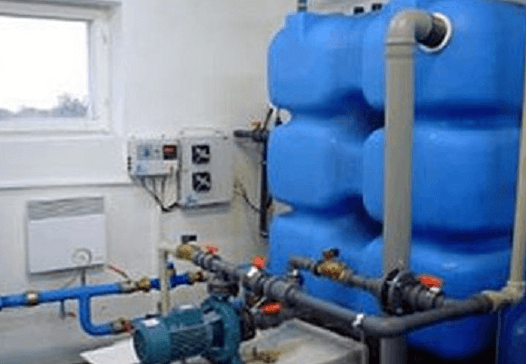
This is manufactured by such a tank made of stainless metal or food plastic mass (plastics).
Required high quality material so that not a single molecule of foreign chemical compounds falls into the water.
After all, it will be used including for food purposes.
In case of a possible breakage of the float crane, a pipe leading into the sewage system is cut into the system so that the flood does not occur when the float fails.
For additional safety and water purification, one or more filters are inserted into the outlet of the tank (pipe).
In cases with late electricity supply, if there may be needed to install a storage system.
If water does not enter the water supply system, such measures will also help the prudent owners of a private house or apartment.
How to choose a water tank
Before making a pump selection, you need to learn a few simple rules that follow from the principles of the accumulative tank. Here they are:
- The larger the volume of water tank, the less the pump will be turned on. Conclusion: Big Buck - economical.
- If he is small, sharp drops of pressure of the waterstore are inevitable and they will occur more often.
Now negative trait Large tanks: they are filled with water for a long time.
As for the shape of the tank, it is horizontal or vertical - it does not matter, there is no difference in the duration.
For the average apartment with water pressure drops in the crane, it is recommended to choose a reservoir, a hundred - two hundred liters. For private-type houses, especially those having a garden or some kind of household plot, the need for clean water increases ten times.
Therefore, such farms need a tank, one and a half thousand liters, and in some cases - five, ten thousand. The more the reservoir, the more rational it is to dig it in the ground in the site, as there is a lot of space.
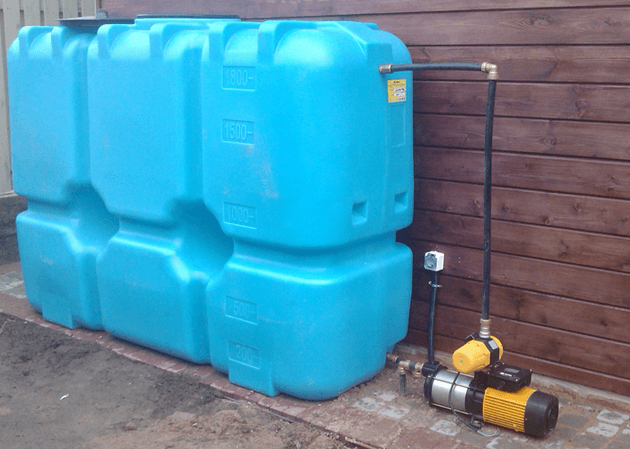
Tanks for giving may have a distinctive feature - they may not be connected to the centralized water supply system, so it is simply not.
It is important not to install such tanks, rather intended for watering plants, under the open sun.
To select the desired size of the accumulating tank for water supply, or apartments, it is required to evaluate the approximate needs of the family and the economy (if available) in water.
Too big tank is as bad as very small.
After all, it is not possible to wait for a larger amount of time until the tank is not rational.
Read more about the principle of cumulative water supply tank, you can look at the video:
Noticed a mistake? Highlight it and click Ctrl + Enter.To let us know.
All ingenious - just! Even in the 21st century, where technical achievements are sometimes incredibly complex in understanding, there is a place for simple and ingenious inventions. One of them is a storage tank for water.
Have questions about installing a cumulative tank? Order a consultation
is free
What is a cumulative tank and do you need you?
The accumulative tank is simple, but very useful device, almost indispensable under autonomous water supply. Even to call it the device seems wrong, because it is the usual container into which water from the well or well is served, and where it subsequently enters the boiler or pipes.
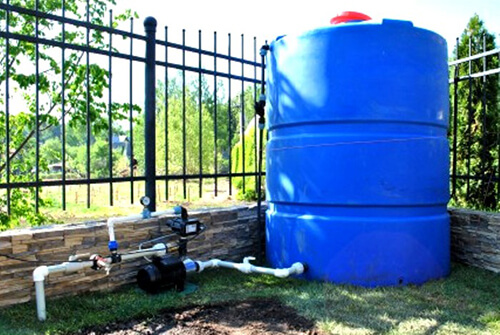
It is difficult for urban residents to understand what problems may result in the illiterate arrangement of autonomous water supply in a private house. They live in the apartment to which water was originally summed up, they have a hot shower, the opportunity to take a bath at any time, wash the dishes, run the washing machine, not to mention the water heating - designers, builders and utilities took care of everything. The source of water supply at the city inhabitant is the most reliable, and all problems with interruptions in the receipt of water are not solved by them.
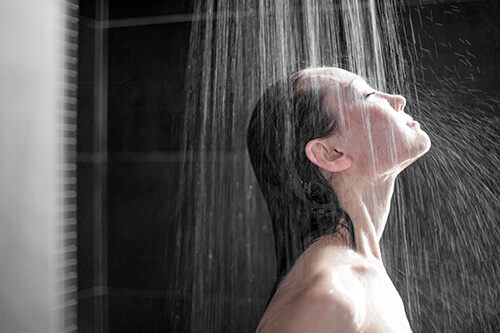
However, those who live in cottage and country villages know how difficult it is to organize a reliable and affordable source of water to which you can connect the pumping station and get the necessary water pressure. Most often conditions country house Not so perfect, for example:
- The house has a connection to a centralized water supply, however, the water here is not served around the clock, but several times a week (this is typical for many country villages);
- There is a well on the site, but its performance is not too high - it will quickly empty and it needs time to fill;
- Water comes from the artesian well, which is almost impossible to dry, but only an automatic pump can be used to supply water, which is turned off in the case of network interruptions.

The cumulative tank acts as a battery, stock water in the period when there is no need for its submission to the house
Private water supply system with cumulative tank
There are two types of water supply systems of a private house with the participation of the accumulative tank - with the upper and lower tank. As it is clear from the name, the fundamental difference here lies in the location of the tank relative to the water supply.
Water supply with top tank
The cumulative tank in such a system is located on the top floor of the house. It works on the principle of water tower. The advantage of this option will be primarily the possibility autonomous work equipment. Water will come to the water intake points naturally, without the use of the pump. However, it is not possible to expect a strong pressure - as we remember, the height difference between the water source and a crane, equal to 10 m, creates a pressure of 1 atm. If you apply it to real conditions and assume that the tank will be installed in the attic two-storey house With the height of the ceilings of 3 meters, the pressure in the cranes on the first floor will be only 0.6 atm, and on the second floor - half less. At the same time, we do not take into account the hydraulic resistance of the pipeline.
Due to the slight pressure of water coming from the top tank, this system is recommended to be used in country houseswhere the need for comfortable water is minimal. For permanent residence in the house will require a more modern approach.
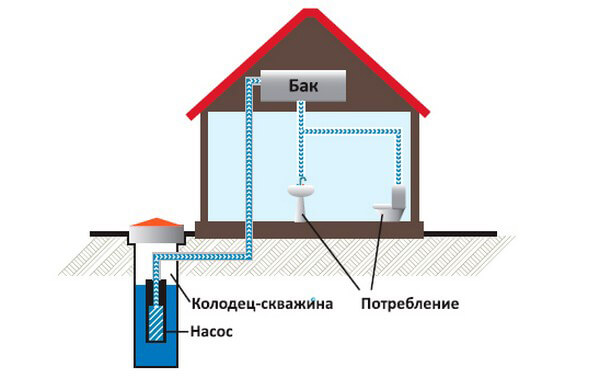
In addition, the indoors installed enough volumetric tank will take useful space. As a summer option, you can install a tank on the street on a special overpass, but for the winter this option will not fit. However, there is an output - electrical heating of the tank and insulation of the pipeline. Calculate how much you will cost you ... No, definitely, it is worth looking for a more rational solution! And it, fortunately, has long been there.
Water supply with lower tank
The lower tank is a solution for those who seek comfort and knows how to properly use the space of the site and at home. The tank is buried in the ground. And even this section of the Earth you can use - I swallowing the tank half the meter below the ground level, you get a plot suitable for growing colors or plants that are not related to root. The sizes of the tank in this case are not limited to anything, and what it is more, the more for a longer period will be able to overlap the difference between the needs of residents of the house in water and affordable resources.
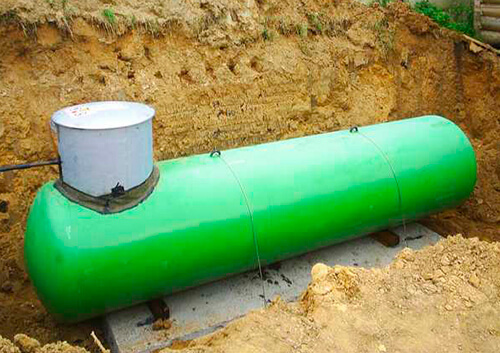
Cons, of course, are, however, they have a completely familiar form:
- You will need a pumping station to extract water from the reservoir and serve it into the house;
- Locating the capacity underground, you make cleaning and repair to hard-to-reach - to facilitate the task, make holes for revision and cleaning, and the tank itself will place a slightly tilt, so that the sediments accumulate in one place (preferably precisely under the cleaning hole);
- In winter, without insulation, the tank may dreamed, and in the spring when incorrect location He will behave.
The plastic tank, burned in the ground, should have either a round shape or ribbing, if both options are not available - create a concrete shell around it
How to calculate the amount of cumulative tank?
In the calculation of the required volume of the accumulative tank, two quantities are involved:
- Water consumption. The average data will be very averaged magnitude to repel from her. Consumption depends on the set of water use in the house and the number of residents. You can only have a couple of sinks and toilet, and can also be installed dishwasher, shower cabin, washing machine, etc. Of course, the difference between two options will be great. In general, the flow per person per day is about 200 liters of water in the presence of all the benefits of civilization. In the conditions of the country house, where water is used for cooking and washing the dishes, this consumption is reduced to about 60 l per day. However, it will be best to calculate your expenses on your own;
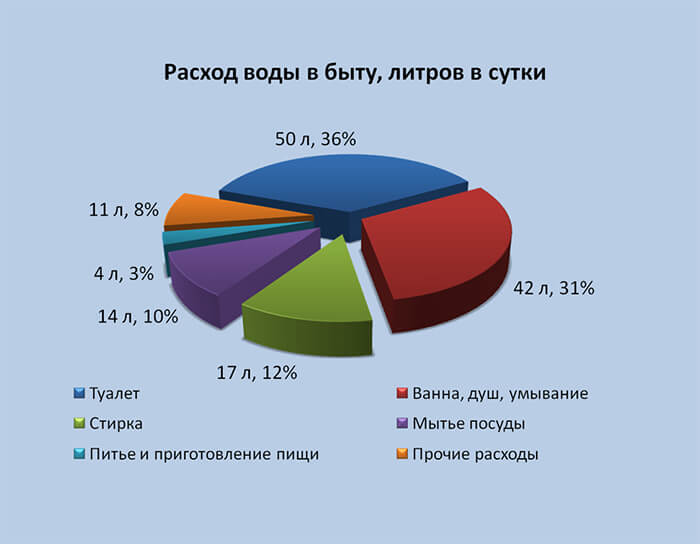
- Frequency of use. Measure your needs and the possibilities of your water supply. You can choose a huge tank, which will fit water for all your needs, but if the power of the system is not enough to pump it into it enough water in the allotted period, the need for a large tank simply disappears. In addition, it is worth considering the reasons why you decide to purchase a cumulative tank - if it serves to insurance from rare and short-term outages of electricity (with a diet of a well) or water (with a centralized water supply), it will be enough for a small tank.
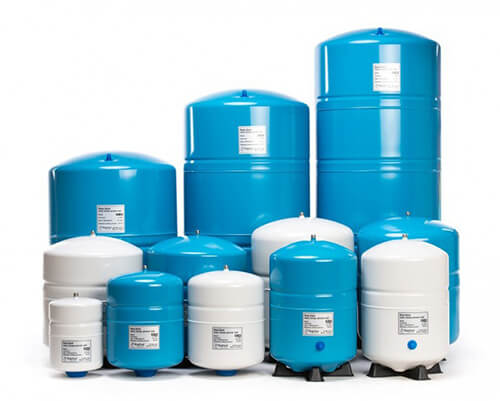
Do not confuse a cumulative tank with a hydroaccumulator serving to get rid of frequent short-term inclusions automatic pump - It spares 25-100 liters of water and is used to save the pump resources and extending his service life.
What makes a storage tank made of?
Cumulative tanks are made of food stainless steel or food plastics. In production strictly followed the quality of the material, because it will be enough to contact the water that will be subsequently used in nutritional purposes.
The features of the design are:
- Float Crane, installed on the inlet pipe. If the house uses autonomous water supply, the crane is replaced with a pump float switch. For warning emergency situations In the case of breakdown, the float cuts the overflow pipe below the inlet, it joins the sewage;
- The input also establishes a filter, which is chosen depending on the degree of water pollution - for relative clean water, the mud is chosen, and for water with plenty of sediment - cyclones or centrifugal pumps;
- Also, the mesh filter is installed on the output tube or directly before wiring into the house;
- If the tank has opaque walls, it is worth cutting into it;
- Underground tanks are equipped with cleaning hatches, and the upper tanks - a drainage pipe embedded at the bottom;
- It is better to use the scatterer to fill the tank with water - it is prevented by mixing and shaking the sediment;
- At the top of the container should be placed ventilation pipeCurved at an angle to the ground. When draining the water and the absence of air access, the tank is deformed.

So, you have already made sure that the cumulative tank is indispensable for a private house. Whatever it is, one clear - it should definitely be. Our consultants will help to choose the cumulative tank correctly, and they will bring it specialists, not the first year of the water supply equipment for private houses.
The main stage of the arrangement of the country house or private bath Is the installation of a modern autonomous water supply system.
To implement it, a reliable cumulative water tank is used.
No less important is the issue of proper placement of the device, so that the finished water supply system has functioned properly throughout the entire life.
The storage tank for water supply is provided to create the required reserve of water for drinking and technical needs.
Such a device is used in modern autonomous hot and cold water supply systems. When the lack of a water source is formed, the drive replenishes it from existing stocks.
Also, water tanks are successfully used in economic needs for the arrangement of summer shower and garden irrigation systems.
Note! The accumulative tank for the bath and at home is intended to store sufficient stock. water resource and maintaining a powerful pressure over the day.
Water tanks are represented by hollow containers of various configurations and volumes, which provide for input and output nozzles, cleaning filters mesh, ventilation holes and technical revisions. More complex models are equipped with additional pumping stations.
Control over the water level is carried out using built-in shut-off valves - float or electronic. The pumping station or submersible pump (in simpler models) flow water from the finished source to the drive.
Filling capacity occurs to the required level, after which the regulator (float crane) is triggered and the fence is completed.
When draining the water, the pump automatically turns on, and the process of supplying the fluid begins again.
Cumulative water tanks can be divided into several categories:
- In the form of execution - round, cylinders, rectangular, non-standard;
- According to the design - open (with a neck, protected by a lid and without) and closed (fully sealed);
- On the material of the manufacture - from plastic, metal, polypropylene;
- On the inner volume - from 20 to 30 liters (small), from 50 to 10 thousand liters (large);
- For its intended purpose - for water supply (cold, hot), summer soul, irrigation systems, water reserves;
- According to the method of installation - vertical and horizontal placement, inside and underground.
Plastic
The most popular and practical are models of plastic tanks, which differ simplicity of production, low weight and low cost.
Big tanks are longer filled with water compared to small tanks, but are more economical. After all, the more volume, the less the pump is turned on.
Metal
Metal tanks are made of stainless steel, corrosion resistant and mechanical damage. This determines the high cost of such reservoirs, so they are often manufactured to order.
To reduce the negative impact of corrosion, metal containers for hot water Inside are covered with a reliable heat-resistant enamel layer.
The most accessible option is plastic or polypropylene accumulative tanks with an appropriate level of thermal conductivity.
Location of water tanks
The location of the tank determines the type of plumbing and equipment that is required for reliable and continuous operation of the autonomous system.
The modern accumulative capacity for the water supply at home and the bath has two installation options - the upper and lower position.
Upper position
Similar scheme provides installation cumulative capacity At the maximum allowable height - terrace, the second floor, the attic, on the roof or under the ceiling. The altitude of the arrangement is proportional to the power of the pressure - for every 10 meters is added according to 1 pressure bar.
When operating a hydroaccumulator in winter, the device is additionally insulated.
The top location provides the best water intake even without using a pumping station, as well as simple and safe operation Capacity.
Lower position
This method of installation cumulative reservoir Provides for rational use of free space. In this case, for the supply of water to the house or bath requires the presence of a pump or pumping station.
With lower accommodation, the water is injected into the drive, as a result of which a special air layer is formed. When a certain level of water is reached in the reservoir, air with maximum power Pulls it to the fence points.
Often, to achieve optimal pressure when water supply, a submersible drainage pump is used with a float installed inside the tank.
If lower placement water reservoir is planned to be used in winter, then it must be shuffled into the soil at a depth below the level of its freezing.
Additionally, reliable insulation is provided. When installing a summer water supply system, the drive can be located at a depth of 45 cm from the top level of the soil.
Important! With underground installation method, the tank must be installed with a small slope of up to 16 degrees. This will provide one-sided accumulation of sedimentary masses under the lid.
Mounting process
The most accessible version of the organization of the autonomous water supply system in the house or bath is the installation of a capacitance on an attic room.
To do this, make or purchase a tank for the battery of the required volume and configuration.
Installation of the container is made on the top boy overlap Or in any convenient place of the attic.
Installation work is carried out in stages:
- Strengthening the base under water tank. Overlapping beams are covered with wide boards.
- A drive is installed on the prepared foundation.
- Installation of the float type valve is made. 7.5 cm retreats from the upper edge, they make a mark and cut the hole of the required diameter. In the hole, the tail portion of the valve with a plastic sealing washer is taped. From the opposite wall of the container, a special plate of stiffness is installed, another sealing washer and the nut is screwed down. All fasteners are securely fixed, a connector is screwed to the tail part, with which the water pipe is connected.
- A holes are done for the discharge pipes of the desired size. In the finished holes on the inside of the container, the connector with a washer is screwed. Strengthening the thread is performed by a special tape. Next is put on the washer, and the nut is tightened.
- The valves of the lock type are inserted into the removal pipes.
- Plugs. To do this, a 2.5 cm mark is installed below the placement of the float type crane and the hole is done. The overflow tube is displayed in the sewer system, it is fixed to the walls of the tank using connections by a similar principle. Next, the pipe is performed with compression fixation. The finished areas of the pipeline system are mounted to the walls of the tank and the wooden base.
- The connected tank is filled with water to check the tightness of the system, as well as the regulation of the float crane.
- The insulation of the container using a sheet polystyrene or rolled mineral wool is performed.
This simple and reliable way can be equipped autonomous system Water supply, the main element of which is a storage tank for a bath or at home.




